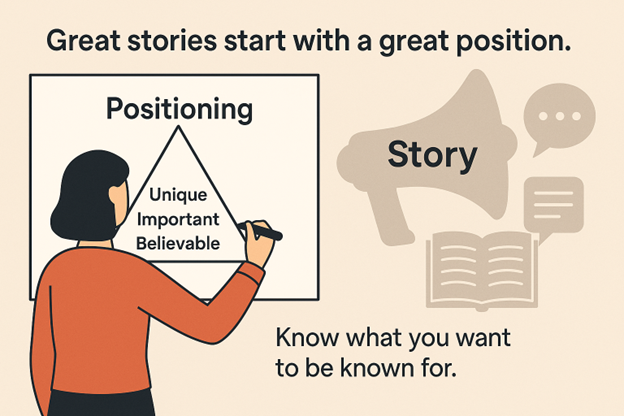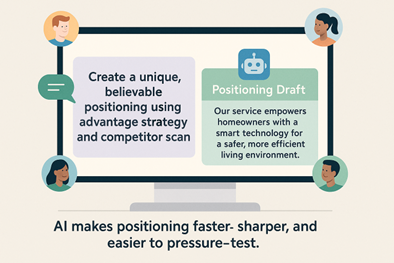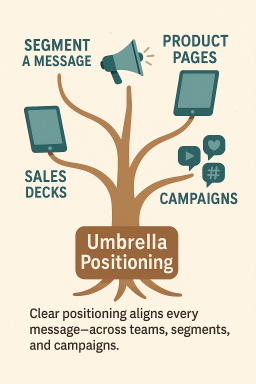Before you craft the perfect narrative, know what you want to be known for.
Everyone is trying to tell better stories right now—across campaigns, presentations, product launches, and social media. But in the rush to sound fresh or emotional or creative, many teams skip the one step that makes all storytelling work: clear positioning.
Positioning is the foundation of great storytelling. It defines what you want to be known for—what you can claim that is unique, important, and believable. And without that foundation, storytelling becomes disconnected, forgettable, and easy to tune out.
We’ve always believed positioning is where good strategy turns into great story. Now, with AI, the process of crafting that positioning has become faster, sharper, and a lot more fun.
1. Why Positioning Still Trips People Up
In workshops, we often guide teams through customer needs, segmentation, ability to win, and differential advantage – all before asking them to develop a clear positioning. By that point, they’ve done the work. The logic is there. The insight is there.
But when we get to the part where they must claim something in the customer’s mind? That’s when momentum can stall.
Too often, teams fall into safe, copy-paste language that could apply to any competitor. We use the “scratch-out test”—if you can scratch out your name and replace it with a competitor’s, it’s not a strong positioning. No matter how compelling your story sounds, it will feel like background noise.
2. How AI Supercharges the Positioning Process
This is where AI has helped breathe new life into the most human part of strategy. Here’s how:
- It fights writer’s block. Prompt AI to create a draft using your segmentation, advantage strategy, and ability to win scores, and it will give you a starting point that is unique, relevant, and on-message.
- It finds unclaimed territory. Even if your product isn’t objectively unique, AI can scan your competitors’ messaging and uncover ideas no one else is emphasizing, letting you plant your flag in uncontested mental space.
- It makes positioning actionable. One client recently fed a draft position into AI and asked, “What do we need to do to make this sustainable?” It came back with specific risks and requirements, ensuring the team didn’t just make a promise, but knew how to deliver on it.
- It keeps storytelling aligned. In another case, a company asked AI to evaluate how well their various product websites reflected their umbrella positioning. The feedback was clear: 30% of statements were off-message or internally focused. That audit helped them reconnect messaging with strategy and story with meaning.
3. From Positioning to Execution—Without Losing the Thread
With strong positioning in hand, storytelling becomes far easier to scale. AI can help tailor messages for each segment, align sales and marketing on the same message, and even draft creative variations that still anchor back to the core position.
You can even take it further: some clients use AI to test which stories have the best chance of moving the market. If we say this, and it boosts our ability to win score, will it increase market share? Is it worth the investment? What’s the upside and the cost?
That’s not just good storytelling. That’s storytelling backed by strategy.
The Bottom Line
The best stories – the ones that stick, scale, and sell, start with clear positioning.
If you want your team to tell better stories, start by answering the positioning question: What do we want to be known for—and why should anyone believe it? Then use AI not to replace your thinking, but to elevate it. Positioning is the parent of great storytelling.
AI just helps you raise it right.

 Mary Abbazia
Mary Abbazia Tom Spitale
Tom Spitale Sean Welham
Sean Welham

